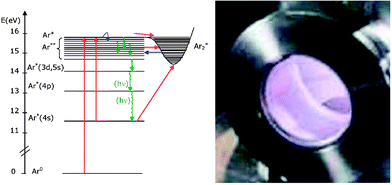The afterglow mystery of pulsed glow discharges and the role of dissociative electron–ion recombination†
Abstract
It is generally recognized that excited level populations and, hence, optical emission intensities in pulsed glow discharges exhibit a peak upon pulse termination, i.e., in the so-called afterglow. This afterpeak formation is attributed in many papers to electron–ion recombination, but up to now this hypothesis could not be confirmed quantitatively by numerical modelling, because of too low electron and ion number densities and recombination rate coefficients. In the present paper, we show the calculation results of a model, which includes also Ar2+ ions, beside the Ar+ ions, and which takes into account the thermalization of the electrons upon pulse termination, yielding higher recombination rate coefficients. The role of electron–Ar2+ dissociative recombination and electron–Ar+ three-body recombination as afterpeak formation mechanisms is investigated. Our study clearly shows the important role of Ar2+ ions and dissociative recombination in the afterpeak formation in the afterglow of pulsed discharges.


 Please wait while we load your content...
Please wait while we load your content...